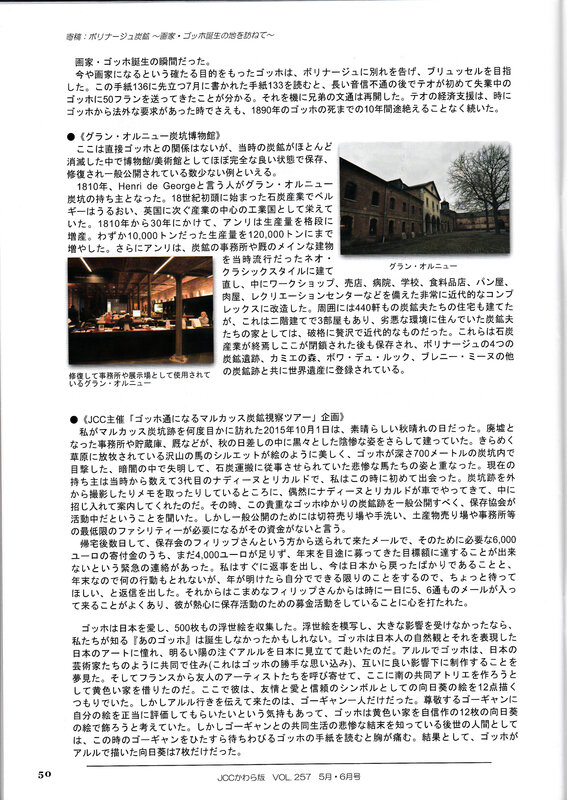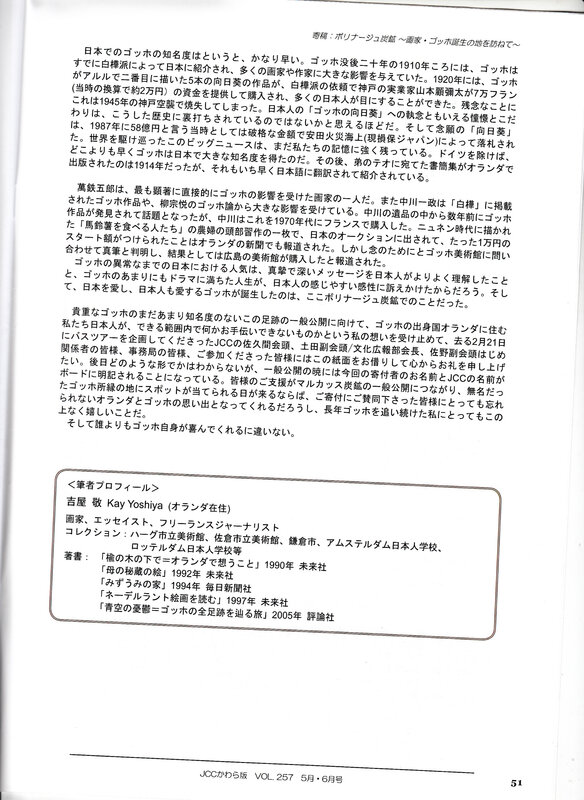Marcasse in the Japanese press
Article for The Mainichi Shimbun,
written by Kay Yoshiya
(English translation)
"Missionary Work of Young Vincent van Gogh"
- Let's support preservation project set up by local people in Borinage-Belgium
In December 1878, 25-years old Vincent van Gogh came over to Borinage, coal mines area in southern part of Belgium, to stay till October 1880; the first half of his stay in this region he spent as a missionary, and the latter half as a strayer.
2 years earlier (1876), he was discharged from art firm Goupil where he worked as art trader. At that time he wanted to become a pastor but because of advice of his private Latin/Greek teacher he gave up that idea. Then he decided to study at a missionary school instead, but he could not get his diploma after all effort. Nevertheless, he decided to go to Borinage and to do missionary work, first at his own expenses, but later he could get small amount of salary from the Missionaries Foundation.
Borinage at that time was the pride of Belgium, being major coal-mining industrial area in the world, but the working situation for mine workers was notoriously bad and harsh. Van Gogh was convinced that the workers with heavy work load in a narrow, dangerous underground mines were entitled to get God's blessing & light, and believed that it was his mission to convey the gospel to these poor people.
Vincent had difficulty in communicating with workers in French dialect, but did his utmost to fulfill his mission as good as possible. In 1879 there was a huge explosion accident at another coal mine nearby Marcasse, and many people died and wounded. Van Gogh rushed to that mine and tried to save as many injured workers as possible, even by tearing his own clothes in pieces to use them as bandage. Stoicism and excessive self-sacrifice are the features to be seen at each time line during his whole life. However, the inspectors of his employer Missionaries Foundation, by looking at this situation, judged his extreme deed "not good for the standing of a missionary" and fired him despite Vincent's extraordinary devotion to his work.
He lost his life target and his job and spent his days in a house of poor mine worker without doing anything. One day he decided to go to Courrieres at Pas-de-Calais, a place of northern France near Dover Channel, by walking nearly 200km. There lived a painter Jules Breton, who was famous for his paintings of poor farmers and workers as main theme and Vincent had high esteem for the works of this painter. Vincent wanted to get any advice from him, but upon arrival at Breton's luxurious house, he hesitated and left Breton's house without ringing the door bell.
On the way back to Borinage he spent a night in a hay in front of a farm house somewhere, and when he awoke in coldness of frost on his face, he suddenly decided to become a painter. This was for him a revelation from the heaven, and here the painter Vincent van Gogh was born. At the age of 27 he finally found the calling of his life. He bade farewell to his strayer's life and left Borinage for his new destination.
In Borinage there are some buildings related to Vincent van Gogh still existing, such as his boading house or the place where he preached. Baker Denis where van Gogh stayed a while was completely restored last year and is open to public. Behind this house, at some distance, there is a ruin of Marcasse Mine where van Gogh visited to see the miserable working situation of mine workers; he even went down into the mining shafts to the depth of about 700m to observe the severe underground coal excavation work for the sake of better understanding of these mine workers. In the past I visited the enclosed Marcasse Mine several times but could not see the inside. During my last visit in October, 2015, I coincidentally met the owner of premises, and could happily step into the site to see the still remaining buildings more in detail.
As it was the case with all coal mines in Borinage area, the Marcasse Mine was also closed in 1960 and for nearly 60 years all buildings were left as they were: now blackish ruins of past glory. Present owner of this former coal mine premises, Mrs. Nadine, explains that a preservation-fund is set up since short aiming at fund raising activities and opening of this site to public in due course. Present form of fund collection is to sell local Belgian beer (with label of van Gogh's work) and T-shirts. All donors' names who once donated money by buying these articles will be listed in a panel at the entrance, whenever this historical heritage will be opened to public.
If Vincent van Gogh had no contact with Japanese "Ukiyo-E" (woodcut printing), the painter Vincent van Gogh would not have existed.
Is it not possible for us Japanese to support this fund raising project a bit more, so that more people will come to know about these unknown Belgian footsteps of Vincent van Gogh who loved Japan so much?
Japanese Chamber of Commerce in the Netherlands (JCC)
article by Mrs. yoshiya Kay












/http%3A%2F%2Fstorage.canalblog.com%2F29%2F67%2F809407%2F123699571_o.jpg)
/http%3A%2F%2Fstorage.canalblog.com%2F23%2F57%2F809407%2F134145725_o.jpg)
/http%3A%2F%2Fstorage.canalblog.com%2F71%2F02%2F809407%2F133543861_o.jpg)
/http%3A%2F%2Fstorage.canalblog.com%2F58%2F75%2F809407%2F128247385_o.jpg)
/image%2F1060022%2F20240415%2Fob_cbcb54_img-2283.JPG)
/https%3A%2F%2Fstorage.canalblog.com%2F28%2F34%2F809407%2F134428987_o.jpg)
/https%3A%2F%2Fstorage.canalblog.com%2F48%2F01%2F809407%2F134428924_o.jpg)
/https%3A%2F%2Fstorage.canalblog.com%2F37%2F44%2F809407%2F133837997_o.jpg)
/https%3A%2F%2Fstorage.canalblog.com%2F50%2F95%2F809407%2F133542135_o.jpg)
/https%3A%2F%2Fprofilepics.canalblog.com%2Fprofilepics%2F6%2F9%2F699405.jpg)